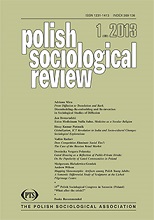Mapping Skeuomorphic Artifacts among Polish Young Adults: A Semantic Differential Study of Sculptures at the Licheń Pilgrimage Centre
Mapping Skeuomorphic Artifacts among Polish Young Adults: A Semantic Differential Study of Sculptures at the Licheń Pilgrimage Centre
Author(s): Andrew Wilson, Małgorzata Haładewicz-GrzelakSubject(s): Social Sciences
Published by: Polskie Towarzystwo Socjologiczne
Keywords: Semantic differential; sacred/profane scale; contemporary pilgrimage centre; skeuomorphic sculptures; young adults
Summary/Abstract: Surprisingly little is known about the religious attitudes of young adults in Poland. Existing scholarship is usually written from a prescriptive view: how young people should behave or what they should do. Quantitive studies, where the researcher's voice is not heard, but, rather, young people have a chance 'to speak' for themselves, appears to be lacking. This article aims to redress this gap to some extent by quantitatively studying young adults' attitudes to sculptures erected in Poland's largest modern pilgrimage venue (Licheń). The paper also aims to contribute to understanding how the sacred is negotiated in a contemporary Catholic pilgrimage venue.We show how respondents actively create the sacrum dimension and how it correlates with the axes of Potency / Activity / Evaluation. We posit a semantically amorphous structure for the sculptural objects at the Licheń centre and use a semantic differential technique to extract affectively oriented dimensions in attitudes towards these skeuomorphic objects. The results highlight important implications for the understanding of religion in post-modernity and of the phenomenon of modern mega-centers of religious worship. They also support the view of secularization and sacralization as two additive concomitant processes, and of 'sacred' / 'profane' as gradient, rather than binary features. SD has been widely used as an analytical tool in sociological research to measure metaphorical meaning and societal attitudes to brands and particular products (e.g. Osgood 1981; Minato 1983). However, it has rarely been applied to investigate the boundary between the sacred and the secular, or ways of objectifying the sacred (e.g. Muth‚n 1977). We explore this possibility, drawing on a dataset of 100 questionnaires administered to undergraduate students in a middle-sized town in Poland in October-December 2012.We hope our research will contribute to an understanding of the wider issue of what societal products like material objects can tell us about experiencing the sacred in contemporary society.
Journal: Polish Sociological Review
- Issue Year: 181/2013
- Issue No: 1
- Page Range: 103-127
- Page Count: 24
- Language: English

